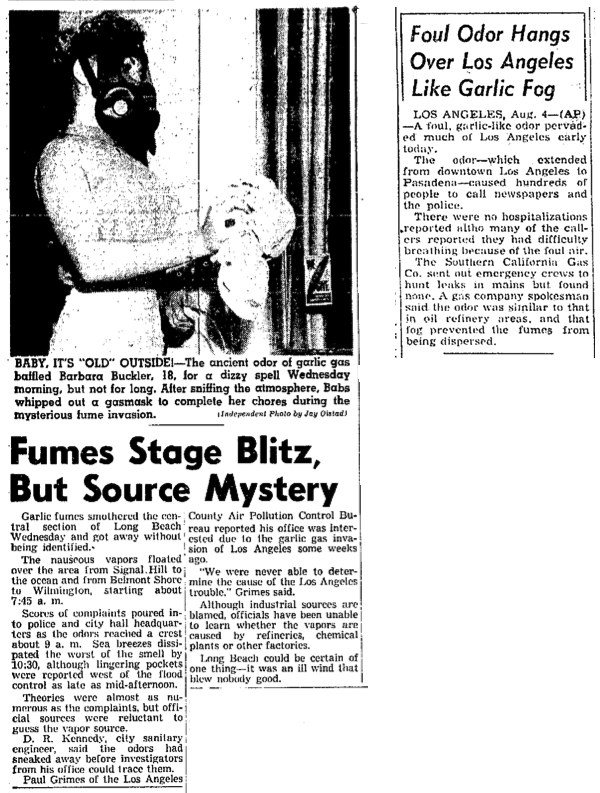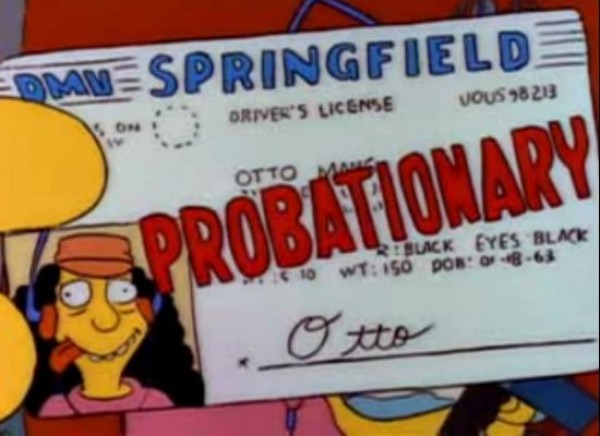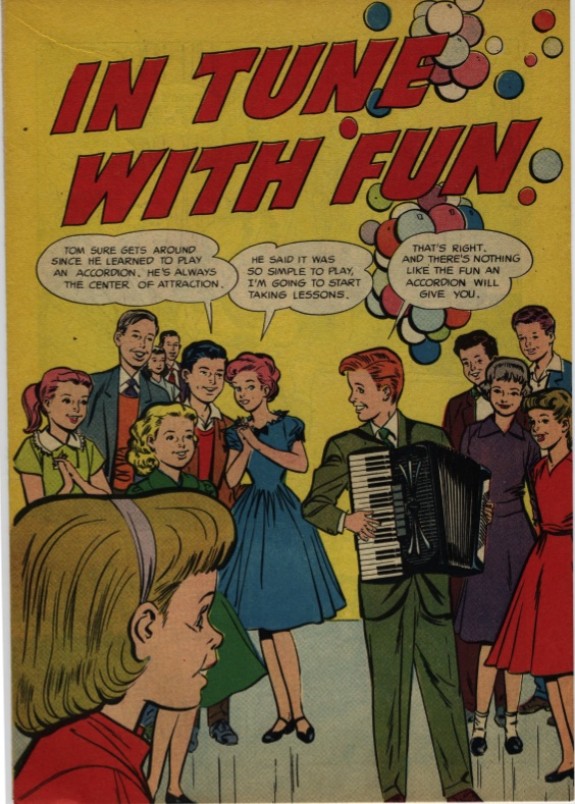December 2012
December 14, 2012
Deputy Scrooge McTicket

Police in Wichita, Kansas act like Scrooge, giving the man who decked out his truck in Christmas lights a $274 fine. He says he will keep the lights, local police say he will keep getting tickets. Bah humbug!
Posted By: Alex - Fri Dec 14, 2012 -
Comments (3)
Category: Holidays
The Charlie Brown School of Dance
Posted By: Paul - Fri Dec 14, 2012 -
Comments (4)
Category: Comics, 1960s, Dance, Parody
Garlic Fog Invades Los Angeles, 1949
Back in late 1949, people throughout Los Angeles County reported a strong odor that smelled like garlic. The smell persisted for weeks, periodically increasing in intensity. Some residents took to wearing gas masks. There were reports of the fumes being so strong that they discolored fences and buildings. There was a widespred fear that it was a poison gas attack.Despite a lot of speculation, I'm not sure that the source of the mystery odor was ever identified, although leading theories were that it was either coming from the Los Angeles River bed, or from a chemical factory. It became known as the invasion of the Garlic Fog. [Sydney Morning Herald, Aug 7, 1949] (via Buried Words and Bushwa)

Posted By: Alex - Fri Dec 14, 2012 -
Comments (6)
Category: Unsolved Mysteries, 1940s, Weather
The Ballad of the Harp Weaver
If anyone can explain to me what the hell this song is about, its logic and mythical allegory, and why it was included on Johnny Cash's Xmas album The Christmas Spirit, I'd be grateful. Any easy answers regarding too much drug and/or booze consumption by Cash will be rejected as too facile.
Posted By: Paul - Fri Dec 14, 2012 -
Comments (14)
Category: Drugs, Holidays, Ineptness, Crudity, Talentlessness, Kitsch, and Bad Art, Children, Parents, 1970s
December 13, 2012
The Ballad of Bilbo Baggins- Leonard Nimoy Sings!
The best comment on this Video, (IMHO), was the suggestion that in be used as the end theme for the new hobbit movie!
Posted By: Tyrusguy - Thu Dec 13, 2012 -
Comments (10)
Category:
Puking Kitty Gravy Boat
Made by GingerEla, who's now raising money on Kickstarter in order to sell these to the general public. Pledge $35 or more to her Kickstarter campaign, and one of these will be yours if she meets her campaign goal of $14,000. She's almost halfway there, with 15 more days to go.
Posted By: Alex - Thu Dec 13, 2012 -
Comments (4)
Category: Art, Food, Cats
Julia Pott
Belly from Julia Pott on Vimeo.
Posted By: Paul - Thu Dec 13, 2012 -
Comments (0)
Category: Anthropomorphism, Death, Oceans and Maritime Pursuits, Surrealism
December 12, 2012
Driving Dogs Earn Licenses plus Cartoon Character LIcenses
These dogs drive better than some people I've encountered on the roads.Here's the link to the Metro report about their training -- one of them is still up for adoption.
http://metro.co.uk/2012/12/11/new-zealand-rescue-dogs-pass-their-driving-tests-3311873/
Here's another video about the car modifications and the training.
With Google's self-driving cars and these driving dogs, I wonder who (or what) will be on the road next?

Cartoon characters? Here's a link to some cartoon licenses.
http://www.huffingtonpost.com/2011/07/21/cartoons-characters-drivers-licenses_n_905949.html#s312463&title=Bart_Simpson
Posted By: gdanea - Wed Dec 12, 2012 -
Comments (6)
Category: Animals
Educational Comics

This site features almost 100 PDFs of vintage educational comics. Endless hours of browsing hilarity.
Thanks to Tom Spurgeon at THE COMICS REPORTER.
Posted By: Paul - Wed Dec 12, 2012 -
Comments (6)
Category: PSA’s, Comics
How To Carve An Elephant
An illustration for this purpose can be found in a sixteenth-century edition of De Arte Coquinaria (On the Subject of Cooking).
A 1905 article in the Strand magazine provides more info about this work:
The work is divided into ten books, beginning with soups, pickles, and sauces, and proceeding through the whole art of cookery, with hundreds of recipes, the very reading of which makes one's mouth water. For instance, who could resist "virgin sow drest with broth made of pepper, wine, honey, oyl, and stew'd damsons"? Or dormouse sausages? ...
There are many recipes in the book to dress "cramp-fish, that numb the hands of those that touch them; the cuttlefish, whose blood is like ink; the pourcontrel, or many feet, the sea-urchin or hedgehog." ...
Then, again, we are given minute instructions for the carving of beasts whose flesh was esteemed by the ancients. "In partes of Asia and Africa," we are told, "the oliphant is eaten, not as the Romans and Egyptians were wont to do, sparingly and only as pertain'd to his feete, trunk, and tayle all of which were great delicacies, but his entire carcase is carved and consumed." For the benefit of those who might happen to possess an elephant and be tempted to eat him a chart of carving instructions accompanies the text.
Posted By: Alex - Wed Dec 12, 2012 -
Comments (5)
Category: Animals, Food, Books, Sixteenth Century
| Get WU Posts by Email | |
|---|---|

| Who We Are |
|---|
| Alex Boese Alex is the creator and curator of the Museum of Hoaxes. He's also the author of various weird, non-fiction books such as Elephants on Acid. Paul Di Filippo Paul has been paid to put weird ideas into fictional form for over thirty years, in his career as a noted science fiction writer. He has recently begun blogging on many curious topics with three fellow writers at The Inferior 4+1. Chuck Shepherd Chuck is the purveyor of News of the Weird, the syndicated column which for decades has set the gold-standard for reporting on oddities and the bizarre. Our banner was drawn by the legendary underground cartoonist Rick Altergott. Contact Us |

